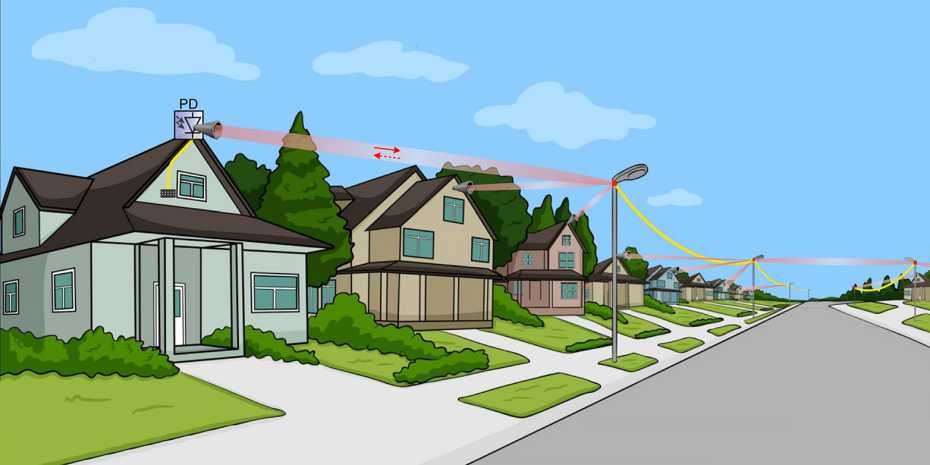Nov 22 2018
An ETH Zurich research team has created a new light modulator with which data relayed through millimeter waves can be directly changed into light pulses for optical fibers. This latest breakthrough could make it significantly cheaper and faster to cover the “last mile” up to the internet socket at home.
 The “last mile” to the internet connection at home is also the most demanding. The new modulator is a viable alternative. In it, data transmitted by millimeter waves (red arrows) can be directly converted into pulses for the optical fiber (yellow). (Image credit: Salamin Y et al. Nature Photonics 2018)
The “last mile” to the internet connection at home is also the most demanding. The new modulator is a viable alternative. In it, data transmitted by millimeter waves (red arrows) can be directly converted into pulses for the optical fiber (yellow). (Image credit: Salamin Y et al. Nature Photonics 2018)
Light waves have high oscillation frequencies that make them perfectly suitable for rapid data transmission. They can effortlessly carry hundreds of billions of bits (gigabits) every second and can be sent via optical fibers.
Conversely, the “last mile” from a central fiber optic cable to the home internet socket is not only costly but also highly challenging. While certain alternatives like 4/5G mobile telephony are more cost-effective, they cannot simultaneously provide the extremely high transmission rates needed by current data-driven applications, for example, streaming TV.
With the help of colleagues at the University of Washington in Seattle, Jürg Leuthold, a professor at the Institute for Electromagnetic Fields at ETH Zurich, and his collaborators have created a new light modulator that might someday make it possible to cover the last mile efficiently and cost-effectively with high-frequency microwaves—the so-called millimeter waves—and thus high rates of data transmission.
Light modulator without electronics
Electronic components are required to rapidly transfer the data encoded in optical fibers through a difference in the light intensity onto millimeter waves, albeit in an expensive manner. In the reverse direction, an antenna has to initially receive millimeter waves, which then have to be amplified and mixed down to baseband and subsequently injected into a light modulator. This light modulator, in turn, translates the data present in the radio waves back into light pulses.
Along with his colleagues, Leuthold has successfully created a light modulator that operates entirely without electronics and batteries. “That makes our modulator completely independent of external power supplies and, on top of that, extremely small so that it can, in principle, be mounted on any lamppost. From there, it can then receive data via microwave signals from individual houses and feed them directly into the central optical fibre,” explained PhD student Yannick Salamin, who played an active role in the development of the novel modulator.
Modulation through plasmons
The modulator developed by the ETH team includes a chip that measures less than 1 mm, and this, in turn, features the microwave antenna. It is this antenna that receives the millimeter waves and changes them into an electric voltage, which subsequently acts on a thin slot at the middle of the chip—the real core of the modulator. Here, a narrow slit, measuring less than a 100 nm wide and only a few micrometers long, is filled with a material that is specifically susceptible to electric fields. Next, the beam of light emitted from the fiber is fed into that narrow slit, but within the slit, the light propagates in a different way from the air or fiber optic cable—as a so-called plasmon and not as an electromagnetic wave.
The hybrid creatures—plasmons—are composed of electromagnetic fields as well as electric charge oscillations at a metal surface. Due to this property, it is possible to confine plasmons much more tightly than that of light waves. Within the slit, the electrically sensitive, or nonlinear, material makes sure that even the smallest electric field produced by the antenna will robustly affect the plasmons’ propagation. That effect on the waves’ oscillatory phase is preserved when the plasmons are changed back into light waves towards the slit end. In this manner, the data bits present in the millimeter waves are directly transferred onto the light waves—without any external power and without taking a detour via electronics.
In one lab experiment with microwave signals at 60 GHz, the team was able to show data transmission rates of around 10 GHz every second across a distance of 5 m, and 20 GHz every second over 1 m.
Cheap and versatile
The novel light modulator, in addition to the negligible energy consumption and small size, offers much more benefits.
The direct transfer from millimetre waves to light waves makes our modulator particularly versatile regarding the frequency and exact format of data encoding.
Jürg Leuthold, Professor, Institute for Electromagnetic Fields, ETH Zurich.
In effect, the light modulator is already compatible with the latest 5G technology as well as with upcoming industry standards that are based on terahertz and millimeter-wave frequencies of 300 GHz and data transmission rates of around 100 GHz every second. In addition, traditional silicon technology can be used to produce the modulator at a relatively low cost.
Lastly, Leuthold can reassure users who might be concerned about the amounts of electromagnetic radiation involved. Unlike the microwaves or radio waves of a Wi-Fi modem, which propagate uniformly in all directions, millimeter waves can be robustly focused for transmission to the outside, and they merely propagate between the roof antenna and a light pole within a beam measuring 20 m in diameter. This considerably decreases the power required for transmission as opposed to other wireless technologies. In addition, it removes the common issues associated with Wi-Fi modems, the signals of which can get in each other’s way.